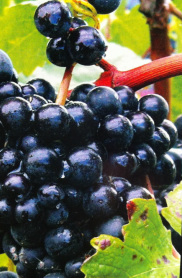 Carignan grapes
Carignan grapes By coincidence, I found myself in possession of 2 bottles of Carignan (or Cariñena as the Spanish call it). One you can buy easily and the other, sadly not available in the UK.
People seem to find it difficult to know what to bring to a wine blogger, especially those who aren't huge wine fans themselves. I like to think of it as fate, then, that I ended up with a random bottle of Chilean Carignan (not readily available in the UK) albeit a Decanter Silver Medal winner, and a bottle of Spanish Cariñena from the wine region where this grape originated - the town of Cariñena of course. Cariñena is in the Aragon region of northern Spain, situated right between Ribera del Duero to the west and Priorat to the east. The Cariñena grape variety finds itself playing a key role in blending and provides a good structural backbone to some Priorat wines.
As Carignan isn't a varietal we've reviewed before, I decided to take the plunge and compare the two. What better way to uncover whether it's "original and best" or "new and improved". Will the Old World hold it's own, or will the New World reign supreme?
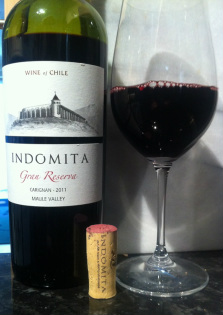 Not currently for sale in the UK
Not currently for sale in the UK Fashions change, and Carignan has gone from being one of the most widely planted grapes in France, to being overtaken by Merlot by the latter part of the 20th century.
Winemakers have come to realise however, that instead of ripping up old vines, which tend to be lower yielding, careful handling can result in seriously concentrated wines of very high quality, and there's recently been somewhat of a renaissance in this grape's popularity. Luckily, both of the wines I'd been given were produced from "old vines".
This was a promising start. Seeing the words "old vines" on a label is often enough to convince me to buy a previously untried wine.
First up, the Indomita "Gran Reserva" (14% abv) from Chile's Maule Valley. It's worth noting, that unlike in Spain, the term Gran Reserva has no legal meaning. It's the wine maker's choice to call his/her wine what he/she will, but generally, we'd expect the Gran Reserva to be retained for his/her best grapes, and wines made with a little more care and attention, perhaps with more use of oak, or hand selection.
The Maule Valley is part of Chile's central valley, 150 miles south of the nation's capital (Santiago). It's the largest, and one of the oldest wine valleys in Chile. Dry-farmed, old-bush vineyards are abundant, and predate the current generation of modern winemakers who've brought Chilean wine to the front of our supermarket shelves.
According to Wines of Chile, Carignan covers only about 2.5% of the land that the most popular variety (Cabernet Sauvignon) covers.
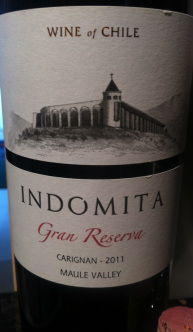 Can a wine taste "tartan"?
Can a wine taste "tartan"? Yes the wine is acidic, but to me this is one of it's qualities rather than a negative. It creates a fruity juiciness that helps to fool the palate into thinking the tannins are less prevalent or less drying than they really are. The fruit flavours tend to red plums and redcurrant, with some kind of smoky chocolate or even coffee flavour on the finish. It's not just a one hit wonder. There's complexity here as the herbaceous notes on the nose continue through to the flavour. When it comes to red wine, I often find myself giving it a flavour "colour-code". This is probably meaningless to anyone else, but to me, this is a kind of green and red tartan where another wine may be described as a purple velvet.
After drinking the first glass, I was happy to pour another. That was unexpected, and a pleasant surprise. Not bad for a bottle that cost 10 € in Finland... (don't ask!)
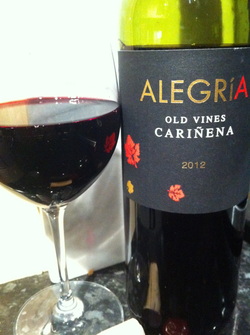 £7.49 at Laithwaites, Spanish Carignan
£7.49 at Laithwaites, Spanish Carignan Again, this was a gift so I'm not able to comment on Laithwaite's value or service. Alegría means joy, in Spanish, so expectations ran high that this would delight the taste buds. I cannot blame the wine for the fact that it cost me one of my Riedel glasses. There's a disadvantage to trying to write a blog post "in real time", but I'm grateful that the wine glass fell on the (thankfully uncarpeted) floor rather than spilling across the laptop itself... but onto the wine.
Structurally, very similar to the Chilean version, there's juicy acidity, lots of tannin, a full body and bags of concentrated fruit flavour. The flavour is different to the Chilean example. There are very few green and herbaceous notes in the Spanish wine. As a result, the dark black and red berry fruit flavours are much more forward and there's lots of spice, with more bitter coffee coming through than the dark chocolate notes on the Indomita.
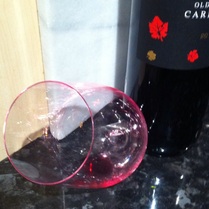 £7.49 plus the cost of a new Riedel tasting glass...
£7.49 plus the cost of a new Riedel tasting glass... Well, it was pleasant, if not delightful. I enjoyed it.
Mr Purple Teeth found it smoky and pleasing, and felt it seemed older than a 2012. He even compared it to a good Bordeaux. High praise, if only for the structure.
When asked to compare it with the previous night's wine, his answer was "did I have wine last night?". Clearly the 4-0 win for Liverpool had induced a pint or two.
Both wines worked better with food. Both provided a pleasant evening (apart from clearing up the spilt wine mess), and only one is available in the UK. So is there any point in declaring a winner?
If pushed, I'd choose the Alegría for a simple evening meal, but if I were trying to impress a wine snob, I'd test them with the Indomita.
<Kudos, that man!>
Cheers!


 RSS Feed
RSS Feed
